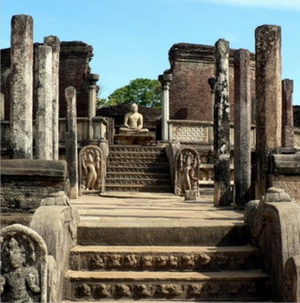 |
| Polonnaruwa |
| The apogee of Polonnaruwa occurred in the 12th century AD. Two sovereigns then proceeded to endow it with monuments. Parakramabahu I (1153-86) created within a triple-walled enceinte a fabulous garden-city, where palaces and sanctuaries prolonged the enchantment of the countryside. The following monuments date from this reign: the Lankatilaka, an enormous brick structure which has preserved a colossal image of Buddha; the Gal Vihara, with its gigantic rock sculptures which may be placed among the chefs-d'œuvre of Sinhalese art; the Tivanka Pilimage, where wall paintings of the 13th century illustrate the jataka (narratives of the previous lives of Buddha), etc. Nissamkamalla hastily constructed monuments that, although less refined than those of Parakramabahu I, were nonetheless splendid: the Rankot Vihara, an enormous stupa 175 m in diameter and 55 m high, is one of the most impressive; its plan and its dimensions are reminiscent of the dagabas at Anuradhapura. |
| After this golden age, Polonnaruwa underwent a century of difficulties, before its final decline. The city which was invaded by the Tamils and the Maghas, then reconquered in a precarious manner, was only periodically the capital before the end of the 13th century when it was captured in an assault by Bhuvanaikabuha II, who set up his government at Kurunegala. |
|